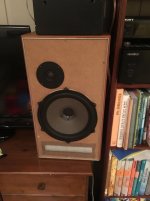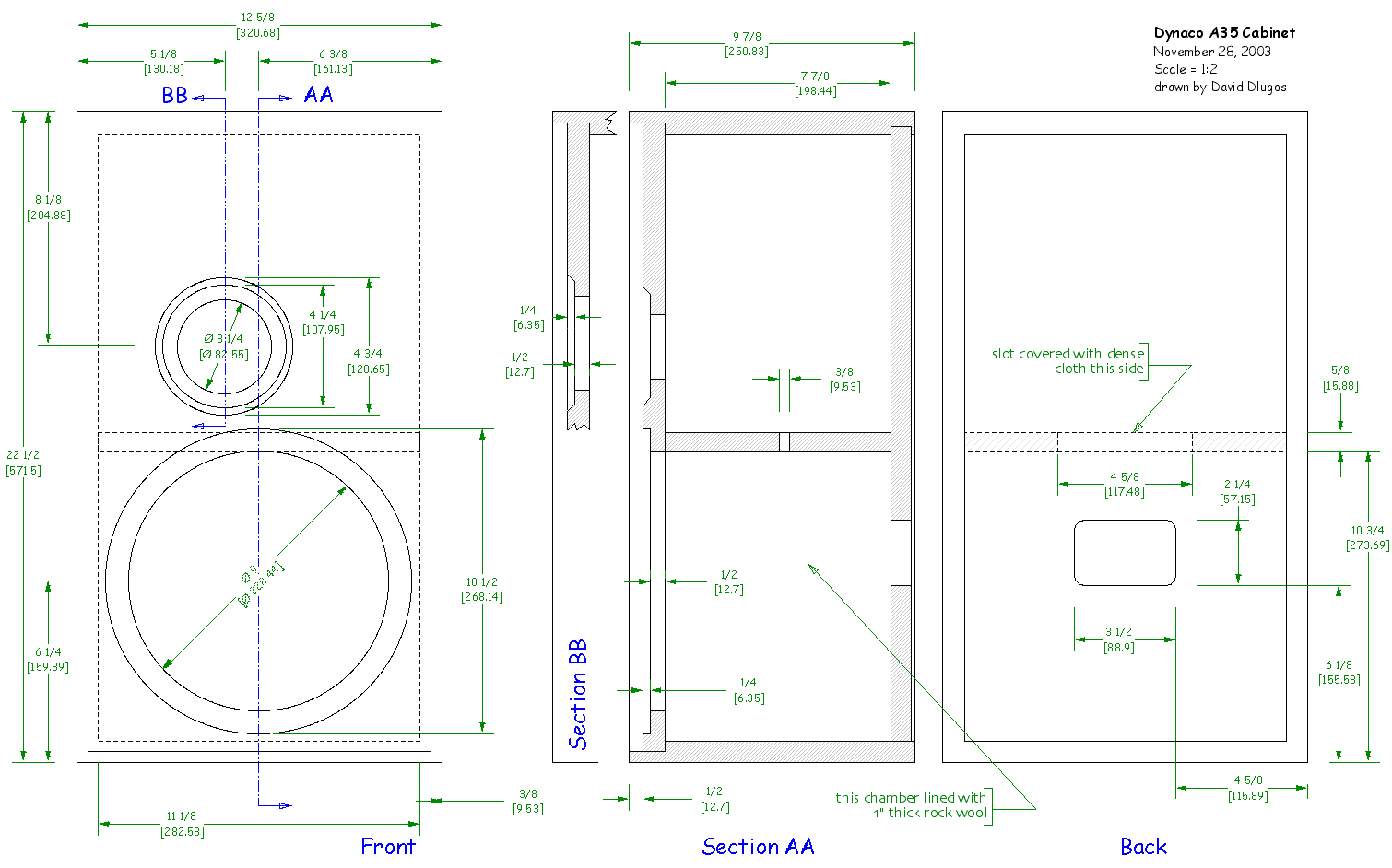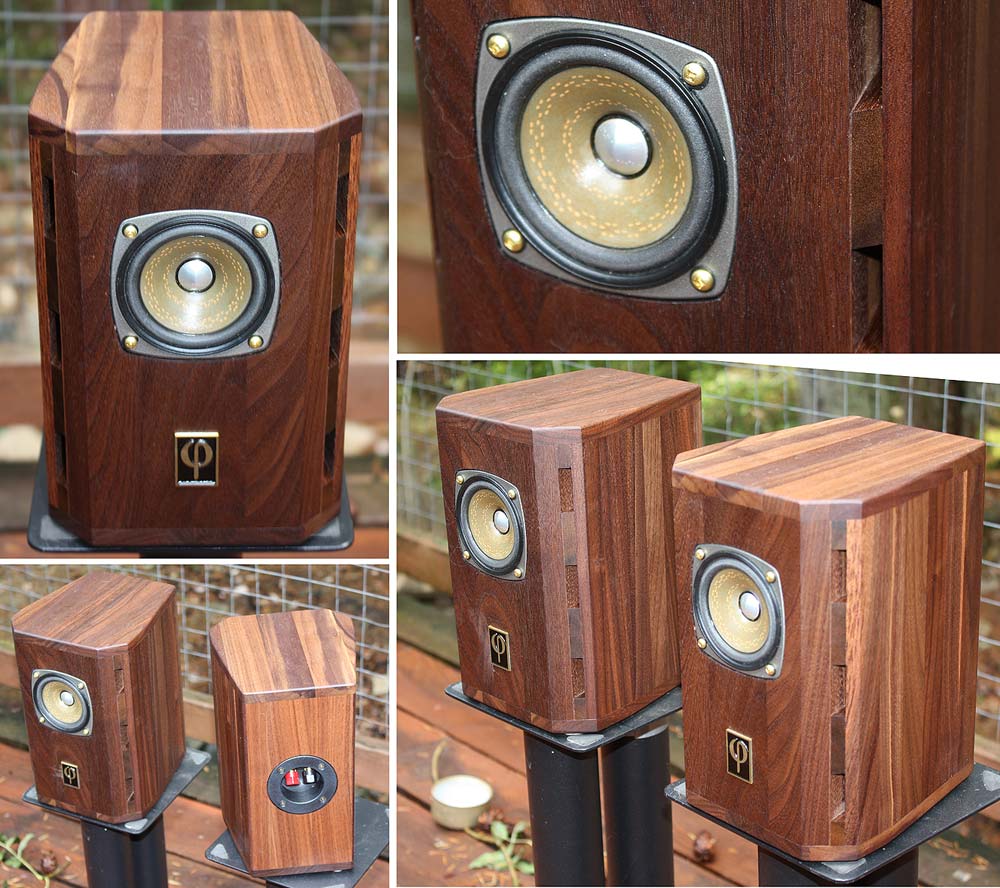Just built a version of this, but with Seas 27TFFFC instead of the original H087 tweeter. Filter is 4.7 uF and 2.2 ohm. I have never heard the original Dynaco 25, but I am stunned by the sound they make with the 27TFFC tweeter.
It is detailed, and at the same time exremely relaxed. It can play loud without being tiring. When pushed very hard on some music you can hear the tweeter struggling a bit, but this is at sound levels much higher than I ever normally listen to.
It is strange to me that a 10" bass/midrange can provide so good midrange! Both male and female voices just sounds magical. I wonder if this is because the lack of filter on the woofer, or is it just an exeptional good driver? It is hard to be believe it was produced in 1971. Bass is not very deep but fast and always present, without being too much.
Have anyone compared the A25 to the new version from seas A26?
I have read that some people just think the A26 is a marketing gimmic from seas just for profit.. I need to the hear the A26 first but I find it hard to believe

It is detailed, and at the same time exremely relaxed. It can play loud without being tiring. When pushed very hard on some music you can hear the tweeter struggling a bit, but this is at sound levels much higher than I ever normally listen to.
It is strange to me that a 10" bass/midrange can provide so good midrange! Both male and female voices just sounds magical. I wonder if this is because the lack of filter on the woofer, or is it just an exeptional good driver? It is hard to be believe it was produced in 1971. Bass is not very deep but fast and always present, without being too much.
Have anyone compared the A25 to the new version from seas A26?
I have read that some people just think the A26 is a marketing gimmic from seas just for profit.. I need to the hear the A26 first but I find it hard to believe

I've never heard either speaker but I do know that there are a lot of myths in audio, so wouldn't be at all surprised if they were very good speakers.
The reason for good male and female vocals is simply a flat frequency response. It sounds like they don't need any baffle step correction and the simple crossover must work with these drivers (very unusual).
On paper aperiodic always seemed like a waste of energy to me but it's not something i've tried. It may be possible to get a bit more low frequency extension with a low tuned port but I wouldn't bother without doing simulations first.
The reason for good male and female vocals is simply a flat frequency response. It sounds like they don't need any baffle step correction and the simple crossover must work with these drivers (very unusual).
On paper aperiodic always seemed like a waste of energy to me but it's not something i've tried. It may be possible to get a bit more low frequency extension with a low tuned port but I wouldn't bother without doing simulations first.
You can get an idea of what will happen in Jeff Bagby "Woofer Box Model and Circuit Designer"
Design a sealed box and play with the Ql value. The only advantage I can see is lower Qtc (assuming you want less bass) and lower impedance peak. The price you pay is higher group delay and increased cone excursion but without the SPL increase.
To me, the Seas A26 looks best in a well stuffed box (about 46ltr according to my sims), but with a port tuned to a very low 22hz (1.59" x 6" port). You'd get more low frequency extension and the low tuning would allow a higher potential SPL/ lower distortion when playing music with deep bass. Although the group delay is a touch higher, the bass would still sound tight because of the very low tuning.
Design a sealed box and play with the Ql value. The only advantage I can see is lower Qtc (assuming you want less bass) and lower impedance peak. The price you pay is higher group delay and increased cone excursion but without the SPL increase.
To me, the Seas A26 looks best in a well stuffed box (about 46ltr according to my sims), but with a port tuned to a very low 22hz (1.59" x 6" port). You'd get more low frequency extension and the low tuning would allow a higher potential SPL/ lower distortion when playing music with deep bass. Although the group delay is a touch higher, the bass would still sound tight because of the very low tuning.
Well, aperiodic boxes aren't technically speaking aperiodic, just a leaky sealed box. Another way of modelling them is a vented box with heavily stuffed ducting. Main use is providing a lower box Q for a given volume -which has its value if the maximum box size you can employ for xyz reason is acoustically too small for whatever sealed box Q you happen to need.
Dynaco A25 sound quality
Have anyone compared the A25 to the new version from seas A26?
The original set Seas 25F-EW and Seas H087.
The 25F-EW magnet is 0.42 kg and the coil inductance is 2.6 mH, and the Seas A26 magnet is 1.1 kg and the inductance is 3.8 mH, so the new one cannot reproduce the mid frequencies so well.
Seas H087 It has a coil diameter of 1.5 inches and can play well from 1.5 kHz. You can replace only the same large diameter - Audax-034, Fostex FT48, Seas T-35.
Seas 27TFFFC on such a low section, especially in the 1st order, will give distortion.
The Dyna A25 has a soft “vintage" top-end and no big sins. In their day they were very competitive, over a million were sold.
Top end can be improved by removing the metal grills on the tweeter and upgrading the crap cap & resistor. I fully expect a new plywood box with flush mount drivers and mirror imaged would dramatically improve things.
The A25 was aperiodic because they needed a small box for both domestic acceptance and cost reduction (cheaper box plus you can stuff more into a shiping container. The same drivers & XO were used in the larger A35, which was sealed but with an internal aperiodic chamber (similar to what some recent NAIM speakers did). The A50 used the same scheme as the A35 in an even largger box with 2 woofers.
Aperiodic boxes are useful when you either need a smaller box than optimal or when the driver Q is higher than you’d like (many vinatge FRs for instance, Visaton B200). I also find it useful to push reflex boxes towards aperiodic, which seems to improve he finesse in the bass, and to make the box less prone to going out of tune as the drivers T/S parameters change due to the dynamics of the music and how high you have the loud control set.
Not a whole lot of research has been done on aperiodic enclosures, but their reduction in the size of the LF impedance peak and the affect on the phase curve can be taken advantage of to get better quallity bass.
dave
Top end can be improved by removing the metal grills on the tweeter and upgrading the crap cap & resistor. I fully expect a new plywood box with flush mount drivers and mirror imaged would dramatically improve things.
The A25 was aperiodic because they needed a small box for both domestic acceptance and cost reduction (cheaper box plus you can stuff more into a shiping container. The same drivers & XO were used in the larger A35, which was sealed but with an internal aperiodic chamber (similar to what some recent NAIM speakers did). The A50 used the same scheme as the A35 in an even largger box with 2 woofers.
Aperiodic boxes are useful when you either need a smaller box than optimal or when the driver Q is higher than you’d like (many vinatge FRs for instance, Visaton B200). I also find it useful to push reflex boxes towards aperiodic, which seems to improve he finesse in the bass, and to make the box less prone to going out of tune as the drivers T/S parameters change due to the dynamics of the music and how high you have the loud control set.
Not a whole lot of research has been done on aperiodic enclosures, but their reduction in the size of the LF impedance peak and the affect on the phase curve can be taken advantage of to get better quallity bass.
dave
(Stunning cabinet !!) fwiw - I ran 4-A35 in the 1970's - those IIRC had ~25mm soft dome tweeters and were very nice - until one day my Citation I tube preamp was turned off prematurely (hooked into the solid state Citation 12). Cone excursion from the turn off transient was about an inch and a half peak to peak, ruining 4 woofers. Dynaco graciously replaced the woofers - but alas, UPS trashed all cabinets upon the return so I gave them away. A35 as P10 knows had two chambers coupled by a damped little slot in the divider. (what's a good way to design a tube preamp with unregulated supply which doesn't spit out turnon/off transients and does not use muting - - FVA did it with his SuperPAS)
A35 in the 1970's - those IIRC had ~25mm soft dome tweeters
The A25/A35/A50 all used alnico 38mm tweeters. The newer A25XL/40XL/50XL, used ceramic mhnet drivers and a 25mm tweeter. I tended to prefer the older ones.
A35 as P10 knows had two chambers coupled by a damped little slot in the divider.

dave
Hi Dave,
"I also find it useful to push reflex boxes towards aperiodic, which seems to improve he finesse in the bass, and to make the box less prone to going out of tune as the drivers T/S parameters change due to the dynamics of the music and how high you have the loud control set. "
Would you mind taking a moment to explain your method(s) for pushing a reflex enclosure towards aperiodic? I'm very interested in this.
Best,
Rich
"I also find it useful to push reflex boxes towards aperiodic, which seems to improve he finesse in the bass, and to make the box less prone to going out of tune as the drivers T/S parameters change due to the dynamics of the music and how high you have the loud control set. "
Would you mind taking a moment to explain your method(s) for pushing a reflex enclosure towards aperiodic? I'm very interested in this.
Best,
Rich
The original set Seas 25F-EW and Seas H087.
The 25F-EW magnet is 0.42 kg and the coil inductance is 2.6 mH, and the Seas A26 magnet is 1.1 kg and the inductance is 3.8 mH, so the new one cannot reproduce the mid frequencies so well.
Seas H087 It has a coil diameter of 1.5 inches and can play well from 1.5 kHz. You can replace only the same large diameter - Audax-034, Fostex FT48, Seas T-35.
Seas 27TFFFC on such a low section, especially in the 1st order, will give distortion.
Well it might do at high levels, but atleas at normal listening levels I cannot hear any distortion. Does not the modern design of the 27tffc outweigh the smaller diameter compared to H087, when it comes to power handling? I see some places that the 27TDFC (wich is the same except different cone materiel) is recommendet as replacement for the H087
I have 4 A25s and had (until they were trashed by a friend) A25XL, which sounded better to my ears. Overall, the bass is quite good for a small box, with no significant hype although one can clearly hear the "one note bass" resonance. The top end is acceptable (especially as a struggling student with little money), and plays well with cheap solid state amps. It works even better with tube pre/tube amps like the the PAS3/ST70. But ultimately the midrange and high end does not satisfy due to a lack of resolution. For example, it is difficult to tell female singers apart, and cymbals of jazz players do not sound well, especially when brushed. But they were very good for their time. They were better than the AR 4ax, and I preferred them to the larger and smaller Advent. YMMV.
Well it might do at high levels, but atleas at normal listening levels I cannot hear any distortion. Does not the modern design of the 27tffc outweigh the smaller diameter compared to H087, when it comes to power handling? I see some places that the 27TDFC (wich is the same except different cone materiel) is recommendet as replacement for the H087
At the usual volume, on the music signal, pay attention to the quality of the high frequencies, and especially to the “air” - they will be reproduced poorer, namely the nuances that the Seas 27tdfc dome is overloaded with a mid-frequency signal.
Last edited:
YMMV indeed - I preferred my AR 4x to the A25, probably because the bass output was close and the AR tweeter actually extended higher than the big dome. Long time ago though; I was likely disappointed in the Dynaco's bass compared with the Large Advent or AR 2ax of the day. And I was an AR fanboy. Never heard an A35, which was probably better, having no leaky hole in the box.
A25 is just a fun speaker.
I think a lot of what makes the A25 special is that woofer. It can be used as a standalone as well as with subs. We were running them with an 18" H Frame open baffle woofer under each one, and they crossed over and sounded very good IMO. The midrange is very nice for a 10". Like a meatier and beefier Boston A100. One gripe is the non mirrored baffles.
There was even a time when I was running the woofer on an 18X24 open baffle, using a pair of EPI inverted domes... Dunno how to describe it, but it was probably my most pleasant sounding open baffle MT to date. Sadly I dropped a tweeter and determined it was better to keep the woofers in the A25's - where safe.
If I were to come across a pair of the A25 woofers at a fair price, I would snap them up. Can think of a few things I would like to try with them.
I think a lot of what makes the A25 special is that woofer. It can be used as a standalone as well as with subs. We were running them with an 18" H Frame open baffle woofer under each one, and they crossed over and sounded very good IMO. The midrange is very nice for a 10". Like a meatier and beefier Boston A100. One gripe is the non mirrored baffles.
There was even a time when I was running the woofer on an 18X24 open baffle, using a pair of EPI inverted domes... Dunno how to describe it, but it was probably my most pleasant sounding open baffle MT to date. Sadly I dropped a tweeter and determined it was better to keep the woofers in the A25's - where safe.
If I were to come across a pair of the A25 woofers at a fair price, I would snap them up. Can think of a few things I would like to try with them.
High-end rolloff of A25
Yes, the lack of high end extension is one area of the A25 and A25XL that I was not satisfied with. However, given that the speakers were likely coupled to limiting poor phono stages and inexpensive solid state amps, that roll-off tended to allow the speaker to lay nice with them. Probably a good trade-off from an engineering and cost standpoint.
YMMV indeed - I preferred my AR 4x to the A25, probably because the bass output was close and the AR tweeter actually extended higher than the big dome.
Yes, the lack of high end extension is one area of the A25 and A25XL that I was not satisfied with. However, given that the speakers were likely coupled to limiting poor phono stages and inexpensive solid state amps, that roll-off tended to allow the speaker to lay nice with them. Probably a good trade-off from an engineering and cost standpoint.
- Status
- This old topic is closed. If you want to reopen this topic, contact a moderator using the "Report Post" button.
- Home
- Loudspeakers
- Multi-Way
- Dynaco A25 sound quality
